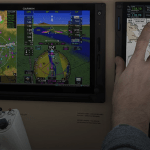Light Relief: GNSS Buddy Road Trip
In a feelgood two-and-a-half minute video cartoon aimed well below its audience’s head, the XinhuaNet.com news service explains BeiDou advantages over GPS and other GNSS. Principally, the script stresses the satnav system’s two-way short message service (SMS) texting capability that can stand in for cellular communications in remote areas and in case of natural disasters that may disable cellular base stations.
 Set to a loping synthesized country rock soundtrack, the entertainment-with-a-message follows a passenger bus through a remote desert. When Buzz the Driver, spooked by a snake, deviates from his planned course, a BeiDou monitoring station quickly detects the error, generates an alarm and sends a message: “Hey, keep yourself focused!”
Set to a loping synthesized country rock soundtrack, the entertainment-with-a-message follows a passenger bus through a remote desert. When Buzz the Driver, spooked by a snake, deviates from his planned course, a BeiDou monitoring station quickly detects the error, generates an alarm and sends a message: “Hey, keep yourself focused!”
The animation gives a nod to other GNSS by stating that “Me and other family members are compatible and interoperable at the user level, which allows us to work together.”















